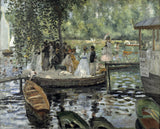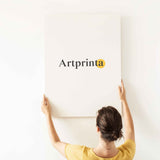Pierre-Auguste Renoir - The Romper - fine art print
Tax included. Shipping calculated at checkout.
Artwork description from the museum (© - by Nationalmuseum Stockholm - Nationalmuseum Stockholm)
English: La Grenouillère, the frog pond was a popular venue for outings from Paris and for bathing in the summer, situated outside Bougival to the west of the capital. The sun is filtered through the green leaves and it sparkles on the surface of the river Seine. People are bathing. Some are in boats, rowing or sailing on the river. A group of men in suits and women wearing crinolines have sought shade beneath a tree on the little artificial island known as Camembert or the flowerpot. It is the summer of 1869 and the painter Auguste Renoir and his colleague and friend Claude Monet are spending some days together. They paint the same subject. They compete to see which of them can most rapidly capture his subjective impressions of what he sees on canvas. Renoir's painting is made up of short and quick brushstrokes using colours straight out of the tube. It is an instant impression caught in a shimmer of colours and reflections from the water. To his contemporaries the painting seemed unfinished; a mere sketch. But today we consider it a textbook example of impressionism. The impressionists’ rapid, sketchy way of painting – their desire to portray their impressions directly on the canvas – was something new. They were breaking with a tradition and they challenged the artistic taste of the times. La Grenouillère represents not only a new way of painting. The subject chosen was also new. They portrayed modernity, la vie moderne, with its commercial and public life. They painted the new department stores, the cafés, the parks and theatres. The male artists were flâneurs, people who wandered randomly about the city observing it. For them, Paris and its environs was a public stage. This stage was entirely segregated as to gender and class in a way that we are often hardly conscious of today. One example of this is to be found in the perspective on the city that one finds among the women impressionists; for example in paintings by Berthe Morisot and Mary Cassat. They portray the city from balconies or a box at the theatre. It was not possible for them to observe street life like the flâneurs; and there were no flâneuses. The gaze of the flâneur is an expression of masculine heterosexuality with freedom to see, to value and to own in fact or in imagination. The role of prostitution in modernity, accessibility to the women of the poorer classes, figures prominently in their paintings. Subjects that we can experience as idyllic today had a very different meaning to people at the time. In Guy de Maupassant's short story La femme de Paul from the 1880s we find a very different picture of La Grenouillère: The water-side café was terribly noisy. Rivulets of beer ran across the tables between half-empty glasses and semi-inebriated people. […] The men sat there with their hats on the back of their heads and their florid, red faces and watery eyes; […] The women, looking for the evening's catch, accepted glasses of beer or wine in the meantime […] The whole place stinks of stupidity, of the rabble, of love for sale. [2013-10-04] Webbtexten sv inlagd ; eng Teknik / Material och eng Förvärv inlagt. Från webbutställning Det Moderna Livet [ABD] La Grenouillère – Groddammen – var ett populärt bad- och rekreationsställe för Paris arbetare och medelklass i Bougival, strax väster om huvudstaden. I september 1869 tillbringade konstnärerna Auguste Renoir och Claude Monet några dagar där. De målade samma motiv, flera gånger ur olika perspektiv. Ambitionen var att fånga ögats intryck – l’impression - av motivet på duken. De arbetade med korta snabba penseldrag i rena, oblandade färger. La Grenouillère representerade ett nytt sätt att måla men också ett nytt slags motiv – det moderna livet och dess kommersiella och offentliga platser
Background data about the unique work of art
| Title of the artwork: | "The Romper" |
| Classification: | painting |
| Dimensions of the original work of art: | Height: 66,5 cm (26,1 ″); Width: 81 cm (31,8 ″) Framed: Height: 84 cm (33 ″); Width: 99 cm (38,9 ″); Depth: 8 cm (3,1 ″) |
| Museum / location: | Nationalmuseum Stockholm |
| Museum location: | Stockholm, Stockholm County, Sweden |
| Website of the museum: | www.nationalmuseum.se |
| License of artwork: | public domain |
| Courtesy of: | Nationalmuseum Stockholm & Wikimedia Commons |
The painter
| Name of the artist: | Pierre-Auguste Renoir |
| Alias names: | Renoar Pjer-Ogist, רנואר פייר אוגוסט, Renoir Pierre-Auguste, Renoir Auguste, Renoir Pierre Auguste, renoir p.a., renoir a., Pierre-Auguste Renoir, Pierre Auguste Renoir, Auguste Renoir, Renoir August, a. renoir, p.a. renoir, Renoir Pierre August, Renuar Ogi︠u︡st, pierre august renoir, firmin auguste renoir, Renoir, רנואר אוגוסט, August Renoir |
| Gender: | male |
| Nationality: | French |
| Professions: | painter, sculptor, illustrator |
| Country: | France |
| Art styles: | Impressionism |
| Died at the age of: | 78 years |
| Year born: | 1841 |
| Birthplace: | Limoges, Nouvelle-Aquitaine, France |
| Year of death: | 1919 |
| City of death: | Cagnes-sur-Mer, Provence-Alpes-Cote d'Azur, France |
Article background information
| Article classification: | art print |
| Reproduction method: | digital reproduction |
| Production technique: | UV direct print |
| Manufacturing: | German-made |
| Type of stock: | production on demand |
| Intended product usage: | wall picture, wall art |
| Orientation: | landscape alignment |
| Image ratio: | 1.2 : 1 |
| Implication: | the length is 20% longer than the width |
| Product material options: | acrylic glass print (with real glass coating), metal print (aluminium dibond), poster print (canvas paper), canvas print |
| Canvas print (canvas on stretcher frame) size variants: | 60x50cm - 24x20", 120x100cm - 47x39", 180x150cm - 71x59" |
| Acrylic glass print (with real glass coating) options: | 60x50cm - 24x20", 120x100cm - 47x39", 180x150cm - 71x59" |
| Poster print (canvas paper) size variants: | 60x50cm - 24x20", 120x100cm - 47x39" |
| Aluminium dibond print (aluminium material) size variants: | 60x50cm - 24x20", 120x100cm - 47x39" |
| Frame: | please consider that this product has no frame |
Pick your desired material
In the product dropdown selection you can select the material and sizeaccording to your individual preferences. Choose among the following product options now to match your preferences in size and material:
- Poster print (canvas material): A poster is a printed flat canvas with a granular finish on the surface. The print poster is particularly suited for putting the art print using a special frame. Please note, that depending on the size of the canvas poster print we add a white margin of something between 2-6cm around the artwork, which facilitates the framing with your custom frame.
- The canvas print: The UV printed canvas stretched on a wood frame. Your printed canvas of your favorite artwork will give you the unique chance of turning your custom art print into a large size artpiece like you would see in a gallery. Canvas prints are relatively low in weight. This means, it is easy to hang the Canvas print without the use of any wall-mounts. A canvas print is suited for any type of wall.
- Aluminium dibond print: An Aluminium Dibond print is a print with an outstanding depth. The Aluminium Dibond Print is the perfect start to art reproductions with aluminum. For the Direct Print On Aluminum Dibond, we print your chosen artwork onto the surface of the white-primed aluminum material. The colors are vivid and luminous in the highest definition, details of the print are crisp and clear, and you can really feel a matte appearance of the product. The UV print on aluminium is one of the most demanded entry-level products and is a sophisticated way to display art, since it puts 100% of the viewer’s attention on the replica of the artwork.
- Glossy acrylic glass print (with real glass coating): A glossy acrylic glass print, which is often described as a print on plexiglass, will convert an original artwork into brilliant wall decoration and forms a viable alternative option to dibond and canvas fine art replicas. Our acrylic glass protects your chosen fine art print against sunlight and external influences for many years to come.
This piece of art was painted by the male artist Pierre-Auguste Renoir. The original measures the size of Height: 66,5 cm (26,1 ″); Width: 81 cm (31,8 ″) Framed: Height: 84 cm (33 ″); Width: 99 cm (38,9 ″); Depth: 8 cm (3,1 ″). Nowadays, this artwork is included in the Nationalmuseum Stockholm's art collection, which is Sweden's museum of art and design, a Swedish government authority with a mandatet o preserve cultural heritage and promote art, interest in art and knowledge of art. With courtesy of Nationalmuseum Stockholm & Wikimedia Commons (public domain).The creditline of the artwork is the following: . Besides this, the alignment of the digital reproduction is in landscape format with a ratio of 1.2 : 1, meaning that the length is 20% longer than the width. Pierre-Auguste Renoir was a illustrator, painter, sculptor of French nationality, whose art style can be attributed mainly to Impressionism. The painter was born in the year 1841 in Limoges, Nouvelle-Aquitaine, France and passed away at the age of 78 in 1919 in Cagnes-sur-Mer, Provence-Alpes-Cote d'Azur, France.
Legal disclaimer: We try what we can to describe the products as precisely as it is possible and to showcase them visually in our shop. Although, the pigments of the print products, as well as the printing can diverge somehwat from the presentation on your screen. Depending on your screen settings and the quality of the surface, not all colors are printed as realistically as the digital version on this website. Bearing in mind that all art prints are printed and processed by hand, there might as well be minor discrepancies in the motif's size and exact position.
© Copyright protection | Artprinta.com (Artprinta)














